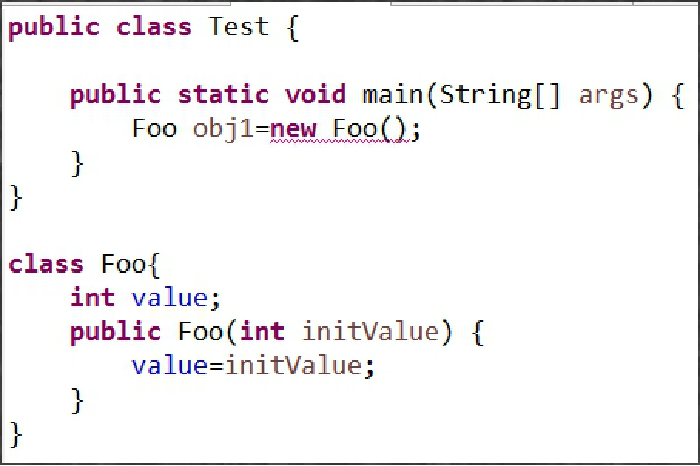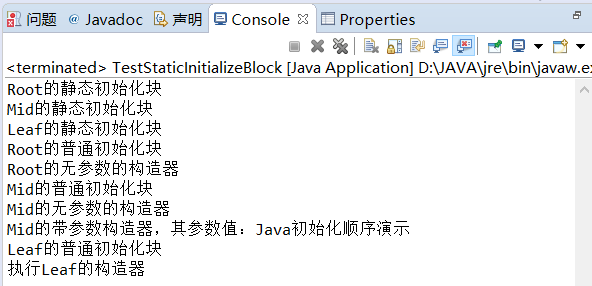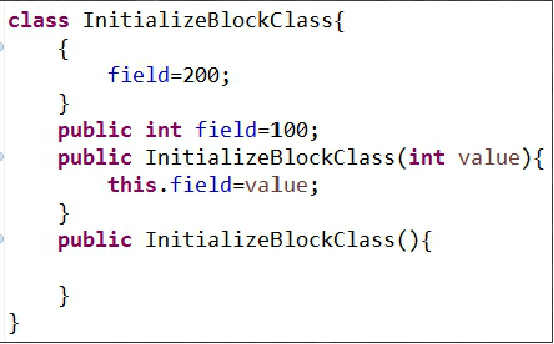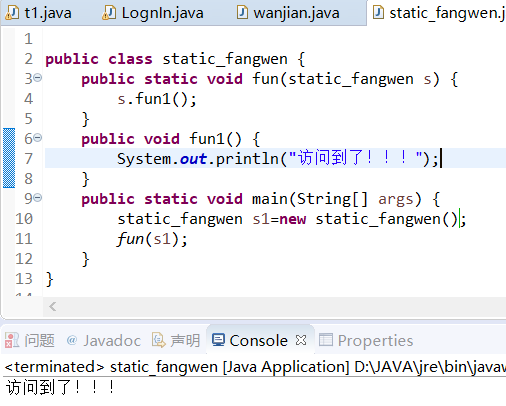2019-10-14-课堂总结
2019-10-14-课堂总结
一,
动手动脑_1:以下代码为何无法通过编译?哪儿出错了?

错在:系统,匹配不到Foo的无参构造方法 !!(如果类没有定义构造函数,Java编译器在编译时会自动给它提供一个没有参数的“默认构造方法”。)但是如果类定义了构造方法Java编译器就不在提供没有参数的“默认构造方法”。只匹配“自己”写到构造方法。
动手动脑_2:
请运行TestStaticInitializeBlock.java示例,观察输出结果,总结出“静态初始化块的执行顺序”。
class Root { static{ System.out.println("Root的静态初始化块"); } { System.out.println("Root的普通初始化块"); } public Root() { System.out.println("Root的无参数的构造器"); } } class Mid extends Root { static{ System.out.println("Mid的静态初始化块"); } { System.out.println("Mid的普通初始化块"); } public Mid() { System.out.println("Mid的无参数的构造器"); } public Mid(String msg) { //通过this调用同一类中重载的构造器 this(); System.out.println("Mid的带参数构造器,其参数值:" + msg); } } class Leaf extends Mid { static{ System.out.println("Leaf的静态初始化块"); } { System.out.println("Leaf的普通初始化块"); } public Leaf() { //通过super调用父类中有一个字符串参数的构造器 super("Java初始化顺序演示"); System.out.println("执行Leaf的构造器"); } } public class TestStaticInitializeBlock { public static void main(String[] args) { new Leaf(); } }

总结:
1,静态初始化块只执行一次。
2,创建子类型的对象时,也会导致父类型的静态初始化块的执行。
动手动脑_3:使用类的静态字段和构造函数,可以跟踪某个类所创建对象的个数。请写一个类,在任何时候都可以向它查询“你已经创建了多少个对象?”。
package jxlPacakge; public class Objnum { private static int sum=0; public Objnum() { sum++; } public static void num() { System.out.println("你已经创建了"+sum+"个对象"); } public static void main(String[] args) { Objnum obj = new Objnum(); Objnum.num(); } }

二,
进行试验_1:使用上页幻灯片中定义的类,以下代码输出结果是什么?

上页PPT代码:


总结:Java字段初始化的规律:
1,执行类成员定义时指定的默认值或类的初始化块,到底执行哪一个要看哪一个“排在前面”。
2,当有构造函数时执行类的构造函数。
(注:类的初始化块不接收任何的参数,而且只要一创建类的对象,它们就会被执行。因此,适合于封装那些“对象创建时必须执行的代码”。)
进行试验_2:
静态方法中只允许访问静态数据,那么,如何在静态方法中访问类的实例成员(即没有附加static关键字的字段或方法)?请编写代码验证你的想法。
想法:将对象作为参数传递给静态方法,这样就可以在静态方法中通过类的对象的调用来访问类的实例成员了!!!

进行试验_3:以下代码输出诡异的结果,原因何在?
public class StrangeIntegerBehavior { public static void main(String[] args) { Integer i1=100; Integer j1=100; System.out.println(i1==j1); Integer i2=129;//false Integer j2=129; System.out.println(i2==j2); } }

用javap来分析生成class文件,看它调用了Interger类的哪个方法:

然后打开JDK源文件查看源码,就可以找到答案是:
/** * Cache to support the object identity semantics of autoboxing for values between * -128 and 127 (inclusive) as required by JLS. * * The cache is initialized on first usage. The size of the cache * may be controlled by the {@code -XX:AutoBoxCacheMax=<size>} option. * During VM initialization, java.lang.Integer.IntegerCache.high property * may be set and saved in the private system properties in the * sun.misc.VM class. */ private static class IntegerCache { static final int low = -128; static final int high; static final Integer cache[]; static { // high value may be configured by property int h = 127; String integerCacheHighPropValue = sun.misc.VM.getSavedProperty("java.lang.Integer.IntegerCache.high"); if (integerCacheHighPropValue != null) { try { int i = parseInt(integerCacheHighPropValue); i = Math.max(i, 127); // Maximum array size is Integer.MAX_VALUE h = Math.min(i, Integer.MAX_VALUE - (-low) -1); } catch( NumberFormatException nfe) { // If the property cannot be parsed into an int, ignore it. } } high = h; cache = new Integer[(high - low) + 1]; int j = low; for(int k = 0; k < cache.length; k++) cache[k] = new Integer(j++); // range [-128, 127] must be interned (JLS7 5.1.7) assert IntegerCache.high >= 127; }
所以会出现这样的输出。





